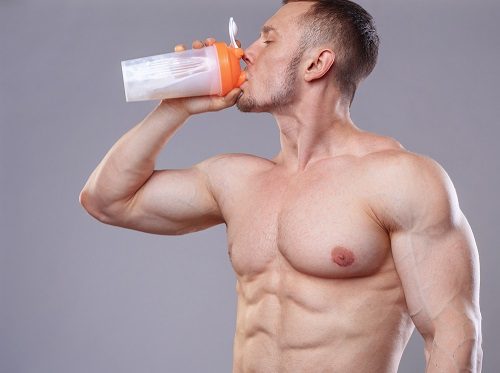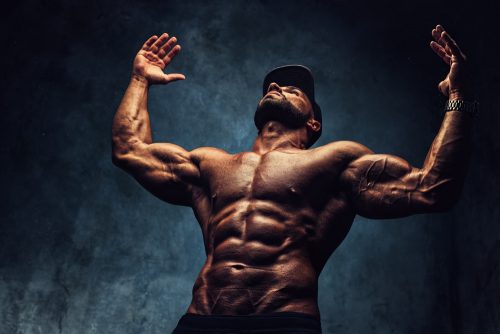
Updated April 2024
While it is possible to train hard and get the physique you want, the eye-popping physiques of professional bodybuilders are rarely the result of eating zillions of calories and spending hours pumping iron in the gym. Those bulging muscles need a helping hand to go beyond the natural capability of any human, and that is where performance-enhancing drugs (PEDs) like anabolic-androgenic steroids (AAS) come in.
Also known as “roids” or “juice”, anabolic steroids are artificial substances used by gym rats and bodybuilders who aren’t happy with their natural muscle growth. When you start taking steroids, you may notice a gain in muscle strength and size, improved recovery and lower inflammation. These changes allow you to work out harder and more often, gaining more strength and muscle mass than your body would do naturally.
Though we don’t advocate the use of steroids for non-medical use, we know many men use anabolic steroids for training or bodybuilding, and we want to help mitigate the risks involved. In this comprehensive guide to post cycle therapy, we have answered some of the most common questions we get asked. Read on to find out how PCT can help you maintain your bodybuilding results while taking steroids or performance-enhancing drugs (PEDs).
Most bodybuilders and athletes use steroids in “cycles” to mitigate side effects and allow the hypothalamic-pituitary-gonadal axis (HPTA) — the system that regulates hormone production — time to increase testosterone production after use. But with any steroid use, the flood of synthetic hormones throws your body off balance. Once you cease anabolic steroid use, your body is slow to recover to normal levels of testosterone. This is where post cycle therapy steps in. Research has shown that post cycle therapy can help reduce withdrawal symptoms from anabolic steroid use and get testosterone production back on track.
The drugs used during post cycle therapy protocol will vary depending on individual circumstances. There are over-the-counter products available for some cases, like testosterone boosters and oestrogen blockers, but generally, these are not powerful enough for steroid users. When you come off anabolic steroids, your body can experience a surge of oestrogen, leading to hormonal chaos. This is where PCT comes in, with drugs like Clomid and Nolvadex used as part of anabolic harm reduction treatment to restore natural hormone balance.
Clomid and Nolvadex are both Selective Oestrogen Receptor Modulators (SERMs) — not to be confused with selective androgen receptor modulators (SARMs) — that regulate post cycle oestrogen production and block the negative effects that it has on the body.
Clomid works by targeting the oestrogen receptors in the hypothalamus and pituitary glands, which can help release luteinising hormones (LH) and follicle-stimulating hormones (FSH) — two hormones crucial to fertility and healthy sperm production. Nolvadex, on the other hand, is great at reducing oestrogen levels and preventing oestrogen surges that can lead to serious health issues like stroke, prostate disease and heart problems.
Although both of these drugs can be purchased online, it is vital to have regular blood tests to monitor your testosterone levels and ensure you are not taking too much. But PCT isn’t just about controlling oestrogen levels. Supplements like phosphatidylserine and acetyl-l-carnitine can also be used to help lower cortisol levels, which can lead to unwanted catabolism — the breakdown of essential body tissues and compounds. This can protect you from loss of muscle mass.
If you are suffering from side effects when you stop the steroids, you will need the help of a qualified doctor to take blood work to see what PCT is best for you and to monitor your hormones. Post cycle therapy is not something you should attempt on your own.

If you see a guy at the gym who seems unnaturally large, he will likely be on performance-enhancing drugs (PED). These are known by many names — human chorionic gonadotropin, growth hormone, anabolic-androgenic steroids (AAS), prohormones, clenbuterol and tamoxifen. When you cease using steroids, testosterone will increase naturally, but this could take up to four months, during which you may experience side effects including:
• Low libido
• Acne
• Disturbed sleep
• Erectile dysfunction
• Depression
• Headaches
• Anxiety
• Loss of appetite
• Nausea.
At Harley Street MD in London, we believe in providing objective advice and the best medical care without judgement. Book a consultation with our men’s health experts so we can find the best post-cycle therapy protocol to meet your needs.
Training during Post Cycle Therapy
It is generally recommended to continue training during post cycle therapy, as exercise can help preserve muscle mass and strength gains that were achieved during the steroid cycle. However, it is important to listen to your body and adjust your training intensity as needed, as post cycle therapy can be a challenging time for your body.
As for training, it’s generally recommended to continue lifting weights but at a slightly reduced intensity and volume compared to your steroid cycle. This can help you maintain muscle mass and strength gains while avoiding overtraining or injury. Focus on compound lifts that work multiple muscle groups at once, and consider adding in some cardio or other forms of aerobic exercise to support your overall health and fitness.
Overtraining should be avoided during your PCT cycle as your body needs time to recalibrate and restore itself to where it was before synthetic hormones were introduced. Ultimately, the key is to listen to your body and adjust your training and recovery strategies as needed during your PCT cycle. You shouldn’t stop working out completely, but consider cutting back on reps. Don’t add extra weight onto usual lifts or undertake heavy-weight training.
Essentially, while your body is recuperating, your training needs to settle down and find its level during PCT. Not too little, not too much — it’s all about finding the right balance. Nutrition is, as always, a key part of healing. Eat nutrient-rich, high-fibre food and hydrate your body with plenty of water. Any supplements could affect the hormonal balance of the body — so again, the doctor overseeing the PCT should be consulted before taking these. With the right approach, you can maintain your gains and support your overall health and well-being during this critical time.
Be gentle with yourself and accept that negative steroid side effects are normal. Your body needs time to heal and return to normality. During your post cycle therapy, it’s especially important to prioritise rest and recovery, which includes getting enough sleep each night.
Getting enough sleep is important for overall health and well-being, and it becomes even more critical during post cycle therapy when your body is recovering from the stress of a steroid cycle. During PCT, your hormone levels are in a state of flux, and you may experience fatigue, mood swings and other symptoms. Adequate sleep can help support your body’s natural hormone production, as well as enhance muscle recovery and repair. Additionally, lack of sleep can increase stress levels and exacerbate mood swings, which are common during PCT. While individual sleep needs can vary, you should aim for seven to nine hours of sleep per night for optimal health and functioning.
If you’re having trouble sleeping during PCT, there are a few things you can try. First, establish a consistent sleep schedule, going to bed and waking up at the same time each day. This can help regulate your body’s natural sleep-wake cycle. Other strategies for improving sleep during PCT include creating a comfortable sleep environment, avoiding caffeine and alcohol before bed and limiting screen time in the hours leading up to bedtime.
In summary, while we do not advocate the use of steroids for non-medical use, a PCT cycle helps restore hormonal balance, reduce oestrogen levels and aids in reaching a natural level of endogenous testosterone.
Post Cycle Therapy FAQ
You should start PCT as soon as you stop taking selective androgen receptor modulators (SARMs) and prohormones. If you have been using steroids, it’s advisable to wait for a week before starting PCT. Naturally, slow-release steroids take longer to leave the body, so it could be several weeks after the last injection is administered until the body is free of artificial testosterone. Once free of artificial testosterone, you can start PCT. Under the care of a qualified physician, post cycle therapy can help to reduce oestrogen levels and reach a natural level of endogenous testosterone to restore hormonal balance.
The post cycle therapy cycle usually lasts for around four to six weeks, depending on individual circumstances. If necessary, post cycle therapy can be extended for several weeks. However, this is dependent upon your circumstances, such as the kind of drugs, the dosage taken and for how long.
Dr Tan is a General Medical Council-registered doctor who has extensive knowledge and experience supporting men with post cycle therapy, whether they are using prohormones, SARMs, human growth hormones or anabolic steroids; blood tests must be carried out during this time.
Bloodwork gives you important details about your general and hormonal health, enabling you to track the effectiveness of your PCT and make any required modifications. If you don’t follow post cycle therapy after the use of PEDs, you’ll find it’s much harder to recover your natural testosterone levels, side effects will be more severe and last for longer, and you may lose the muscle gains you’ve worked so hard to achieve.
At Harley Street MD, we focus on offering outstanding medical care without passing judgement. Schedule a consultation with one of our men’s health specialists so that we can recommend the most effective post cycle therapy protocol for you.
The research and study references we used, in addition to our internal research, have all been referenced here; most of them have an external link to the scientific publication. We work hard to bring you the most recent, impartial, factual and evidence-based information to help you make informed decisions.
References
• The use of post-cycle therapy is associated with reduced withdrawal symptoms from anabolic-androgenic steroid use: a survey of 470 men. Published online 2023 Nov 11. From: NCBI
• Full recovery may be possible among men who use steroids for muscle growth. Published online 2023 Nov 11. From: Endocrine Society
• Harm Reduction in Male Patients Actively Using Anabolic Androgenic Steroids (AAS) and Performance-Enhancing Drugs (PEDs): a Review. Published online 2021 May 4. From: Journal of General Internal Medicine